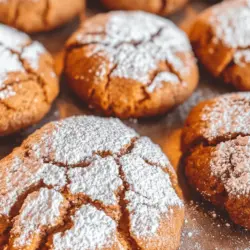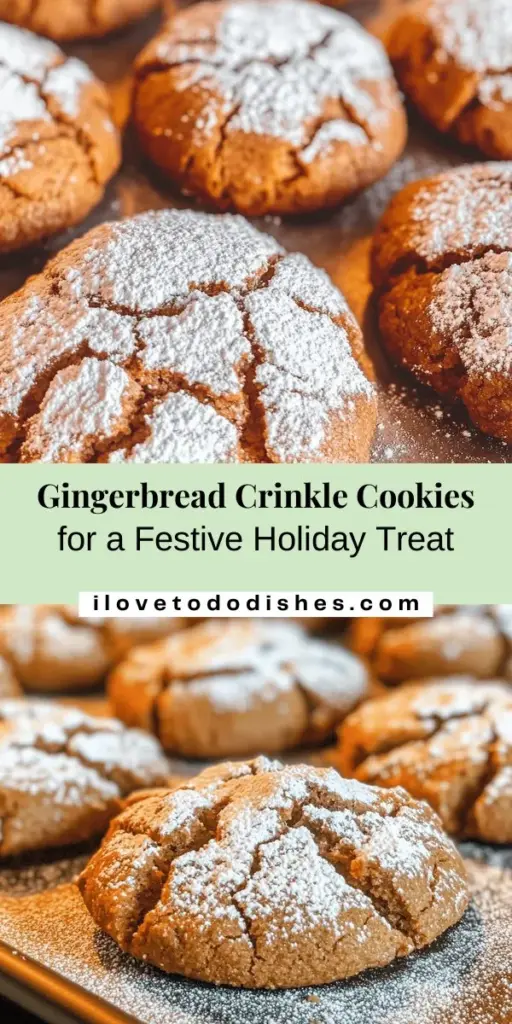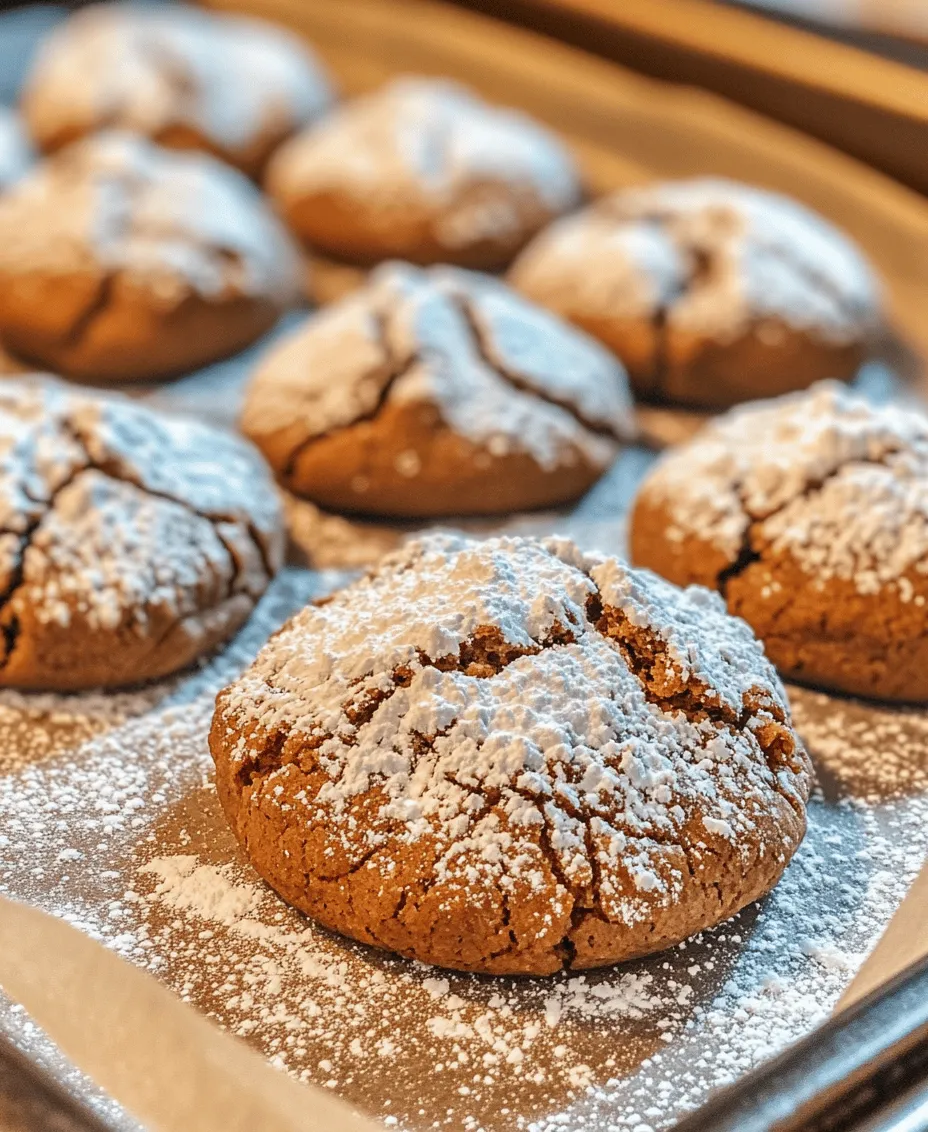Introduction
As the holiday season approaches, the air fills with the warm and inviting scents of baking, signaling the festive spirit that envelops homes across the globe. Christmas baking has become a cherished tradition for many, infusing joy and creativity into the season. Among the myriad of treats that emerge from ovens during this time, gingerbread cookies stand out as a beloved classic, evoking nostalgia and warmth with every bite.
Gingerbread cookies, with their distinctive blend of spices and rich flavor, have been a staple in holiday baking for centuries. Originating in ancient times, these sweet, spiced delights have evolved into various forms and recipes, making them a central figure in Christmas celebrations. This year, we invite you to try a delightful twist on the traditional gingerbread cookie: Christmas Gingerbread Crinkle Cookies. This innovative recipe combines the classic flavors of gingerbread with a unique crinkle effect, resulting in cookies that are not only delicious but also visually captivating.
Understanding the Appeal of Gingerbread Cookies
The history of gingerbread cookies dates back to ancient Greece and Egypt, where they were often used in religious ceremonies. However, it was during the medieval era in Europe that gingerbread began to take on the form we recognize today. The cookies were shaped into various designs and often decorated with icing, becoming a festive treat that symbolized abundance and good fortune.
As we delve into the world of gingerbread, one cannot overlook its unique flavor profile. The combination of spices such as ginger, cinnamon, nutmeg, and cloves creates a warm, aromatic experience that is synonymous with the holiday season. Each bite offers a comforting embrace, reminiscent of cozy evenings spent by the fire, surrounded by loved ones. The deep, rich aroma that wafts through your kitchen while baking is enough to transport anyone to a winter wonderland.
Visually, gingerbread crinkle cookies are a feast for the eyes. Their signature crinkle effect, created by rolling the dough in powdered sugar before baking, results in a beautiful contrast between the dark, spiced cookie and the snowy white sugar. This striking appearance makes them perfect for holiday gatherings, cookie exchanges, or simply to enjoy with a cup of hot cocoa.
Ingredients Breakdown
To create the perfect batch of Christmas Gingerbread Crinkle Cookies, it is essential to understand the role of each ingredient in the recipe. Here’s a detailed look at the key components that come together to create these festive delights.
All-Purpose Flour
At the foundation of any cookie recipe is all-purpose flour, which provides the necessary structure and texture. The gluten in the flour helps the cookies hold their shape while allowing them to remain soft and chewy. For this recipe, using the right amount of flour will ensure that your cookies achieve the perfect balance between tenderness and stability.
Spices: Ginger, Cinnamon, Nutmeg, and Cloves
The heart of gingerbread cookies lies in the spices. Ginger is the star ingredient, providing a warm, zesty kick, while cinnamon adds sweetness and warmth. Nutmeg contributes a hint of nutty flavor, and cloves offer a subtle spiciness that rounds out the blend. Together, these spices create a symphony of flavors that embodies the spirit of the holidays.
Unsalted Butter
Unsalted butter is crucial in this recipe, as it contributes richness and moisture to the dough. Using unsalted butter allows for better control over the overall salt content in the cookies. When creamed with sugar, butter creates a light and fluffy texture that helps the cookies rise and achieve a perfect bite.
Dark Brown Sugar vs. Granulated Sugar
In this recipe, both dark brown sugar and granulated sugar play essential roles. Dark brown sugar is packed with molasses, which not only provides moisture but also imparts a deep, caramel-like flavor that enhances the richness of the cookies. Granulated sugar, on the other hand, helps to achieve a crisp exterior while maintaining a chewy center. The combination of these two sugars creates a delightful contrast in texture and taste.
Molasses
Molasses is a key ingredient in gingerbread cookies, adding depth and a characteristic chewiness to the final product. This thick, dark syrup not only contributes sweetness but also enhances the overall flavor profile, giving the cookies their signature taste. The use of molasses is what truly sets gingerbread cookies apart from other cookie varieties, making them a must-have during the holiday season.
Powdered Sugar
The final touch in creating the crinkle effect of these cookies is powdered sugar. Rolling the dough balls in powdered sugar before baking creates a beautiful contrast when the cookies expand and crack during baking. This not only adds visual appeal but also contributes a subtle sweetness that complements the spiced flavor of the gingerbread.
Step-by-Step Guide to Making Christmas Gingerbread Crinkle Cookies
Now that we’ve explored the essential ingredients, let’s move on to the preparation of the dough. Making Christmas Gingerbread Crinkle Cookies is a straightforward yet rewarding process that you can easily engage in, even if you’re a novice baker.
Preparation of the Dough
1. Gather Your Ingredients: Start by measuring out all your ingredients and placing them on your countertop. Having everything at hand will streamline the process and ensure that you don’t miss any key components.
2. Sift the Dry Ingredients: In a large mixing bowl, combine the all-purpose flour, ginger, cinnamon, nutmeg, cloves, baking soda, and salt. Sifting these dry ingredients together helps to evenly distribute the spices and break up any clumps, ensuring a smooth dough.
3. Cream the Butter and Sugars: In a separate bowl, use an electric mixer to cream together the unsalted butter, dark brown sugar, and granulated sugar until the mixture is light and fluffy. This process typically takes about 2-3 minutes on medium speed. The creaming process incorporates air into the butter, which is vital for achieving a light texture in your cookies.
4. Add Molasses: Once the butter and sugars are well combined, add the molasses to the mixture. Continue mixing until the molasses is fully incorporated, creating a rich and dark batter.
5. Combine Wet and Dry Ingredients: Gradually add the sifted dry ingredients to the wet mixture, stirring gently with a wooden spoon or spatula until just combined. Be careful not to overmix, as this can lead to tougher cookies. The dough should be thick and slightly sticky.
6. Chill the Dough: To achieve the perfect texture, wrap the dough in plastic wrap and refrigerate it for at least 30 minutes. Chilling the dough helps to firm it up, making it easier to handle and shape into balls later on.
This step-by-step guide sets the stage for creating your Christmas Gingerbread Crinkle Cookies, ensuring that you have a solid foundation as you continue with the baking process. Stay tuned for the next part, where we will cover the final steps of shaping, baking, and enjoying these festive treats!
Chilling the Dough
Chilling the dough for your Christmas Gingerbread Crinkle Cookies is an essential step that should not be overlooked. Refrigeration allows the fats in the dough to solidify, which leads to a firmer texture that holds its shape during baking. If the dough is too warm, the cookies may spread excessively in the oven, resulting in flat, unappetizing cookies rather than the thick, crinkled treats we aim for.
To chill the dough, wrap it tightly in plastic wrap or place it in an airtight container and refrigerate for at least 1 to 2 hours. For optimal results, you can chill the dough overnight, which will deepen the flavors and improve the texture. This waiting period is not only crucial for the cookies’ structure but also builds anticipation for the delightful final product.
Rolling and Coating
Achieving the perfect powdered sugar coating on your Gingerbread Crinkle Cookies is key to their signature look and taste. Once your chilled dough is ready, prepare your workspace with a generous dusting of powdered sugar. The process begins by scooping out portions of the dough—about a tablespoon each—and rolling them into balls between your palms.
Next, roll each ball in the powdered sugar, ensuring it’s generously coated. For the best results, roll the dough balls twice in the sugar: first for an initial coat and then again right before they go into the oven. This double coating will create a beautiful, snowy finish, enhancing the visual appeal of your cookies. Make sure to shake off any excess powdered sugar after coating to avoid clumping and achieve that perfect crinkle effect during baking.
Baking
Now it’s time to bake your cookies! Preheat your oven to 350°F (175°C) and line your baking sheets with parchment paper. Space the dough balls about 2 inches apart to allow for spreading. Bake the cookies for 10 to 12 minutes, keeping a close eye on them towards the end of the baking time. The cookies are done when they have puffed up slightly and the tops appear crinkled and just set.
Avoid overbaking, as this can lead to dry cookies. The edges should look firm while the centers may still appear slightly soft. Remember, the cookies will continue to firm up as they cool on the baking sheet, so it’s better to take them out a bit earlier than later.
Cooling Process
After removing the cookies from the oven, allow them to cool on the baking sheet for about 5 minutes. This cooling period is crucial for maintaining the integrity of the cookies; it allows them to firm up without falling apart. After this initial cooling, carefully transfer the cookies to a wire rack to cool completely. This step ensures that air can circulate around the cookies, preventing them from becoming soggy.
As they cool, the crinkled tops will continue to develop, providing that classic appearance. Be patient and let them cool completely before diving in—this will allow the flavors to meld beautifully, enhancing your overall cookie experience.
The Science Behind the Crinkle Effect
The crinkle effect of these cookies is not just a delightful visual; it has a scientific basis rooted in the baking process. When cookies bake, the heat causes the moisture within the dough to turn into steam. This steam pushes up against the surface of the cookie, creating tiny pockets that lead to the crinkled appearance.
Baking soda plays a critical role in this process. It acts as a leavening agent, helping the cookies rise and creating those lovely fissures on the surface. If too much moisture is present in the dough, the cookies may not crinkle as desired, resulting in a denser texture.
Additionally, the powdered sugar coating interacts with the cookie as it bakes. This sugar layer melts slightly, creating a thin, delicate crust that complements the soft interior. The contrast between the crisp exterior and the chewy center is what makes these cookies so enjoyable.
Serving Suggestions and Pairings
Christmas Gingerbread Crinkle Cookies are perfect for festive gatherings and can be served in various delightful ways. For holiday parties, present your cookies on a decorative platter or in a festive tin, layered with parchment paper for a charming touch. You may also consider arranging them in a mason jar, tied with a ribbon, which makes for a beautiful and thoughtful gift.
In terms of beverages, these cookies pair wonderfully with a steaming cup of hot cocoa, enhancing the warm, spicy flavors of the ginger and cinnamon. Alternatively, spiced cider or a rich cup of coffee can also elevate the cookie-eating experience. For a fun twist, serve them with a scoop of vanilla ice cream for a delightful dessert that combines texture and temperature.
Storing and Preserving Gingerbread Cookies
To maintain the freshness of your Gingerbread Crinkle Cookies, store them in an airtight container at room temperature. They can typically last up to a week when stored properly. If you want to extend their shelf life, consider freezing either the dough or the baked cookies.
For freezing dough, shape it into balls, coat them in powdered sugar, and place them on a baking sheet to freeze. Once frozen, transfer the dough balls to a freezer bag and store them for up to three months. When ready to bake, you can bake them straight from the freezer—just add an extra minute or two to the baking time.
Baked cookies can also be frozen in an airtight container. Layer them with parchment paper to prevent sticking and consume them within three months for the best flavor. Before consuming, allow the cookies to thaw at room temperature. Signs of spoilage include a hard texture or off smell, so be sure to check your cookies before indulging.
Conclusion
Baking Christmas Gingerbread Crinkle Cookies is a joyful experience that brings warmth and festive cheer into any home. The process of mixing, chilling, rolling, and baking creates an atmosphere filled with delightful aromas, making the holiday season even more special.
As you incorporate this recipe into your holiday traditions, remember that the true essence of baking lies in sharing these treats with loved ones. Whether served at a gathering, gifted to friends, or enjoyed at home, these cookies embody the spirit of the season. So, roll up your sleeves, gather your ingredients, and enjoy the magic of the baking process—creating lasting memories and delicious treats that will be cherished for years to come.



